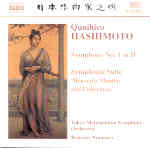Qunihico Hashimoto (1904-49) studied with Egon Wellesz (among others) and expressed interest in the music of Krenek, Hába, and Schoenberg, and yet his own music comes across as characteristically late Romantic. The Symphonic Suite from the ballet Heavenly Maiden and Fisherman features typically colorful orchestration and some very pretty tunes, including one that sounds a lot like the main theme of Tchaikovsky’s Marche Slave. It offers 20 minutes of listening pleasure, plain and simple.
Symphony No. 1 was composed in 1940 in commemoration of the 2,600th anniversary of the founding of Japan, the same occasion that resulted in the scandal surrounding Benjamin Britten’s Sinfonia da requiem (the work was rejected on account of its being based on a Christian theme). Though no masterpiece, the symphony is an unexpectedly graceful example of Romantic Nationalism, beginning with a lovely pastoral opening movement (with interpolated dance and march episodes), proceeding to a deliciously catchy scherzo, and ending with a theme and variations finale. The fugue that caps the variations rises to a remarkably terse and unpompous conclusion, given the occasion in question. Hashimoto writes with a fluency and craftsmanship that places this work on a much higher level than, say, the typical socialist realist potboiler to which it might otherwise be compared. Hopefully most listeners will be able to get beyond the work’s wartime provenance and nationalist leanings and simply enjoy it as the attractive and colorful music that it is.
The Tokyo Metropolitan Symphony Orchestra under Ryusuke Numajiri plays both works with the necessary gusto and panache, and they are superbly recorded as well. Naxos’ Japanese music series certainly looks to be as interesting as its explorations of American, Spanish, and British music, and should help to spark increasing interest in this largely unknown legacy. Give this a try. You won’t be sorry.
































